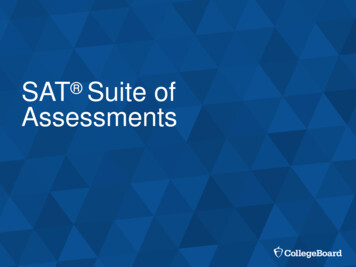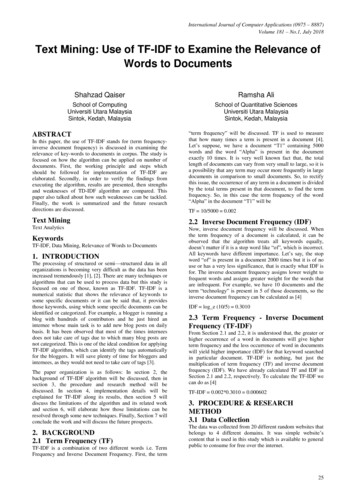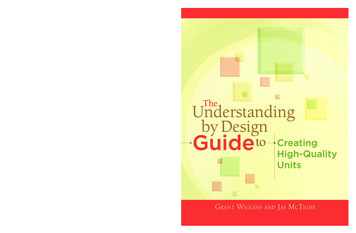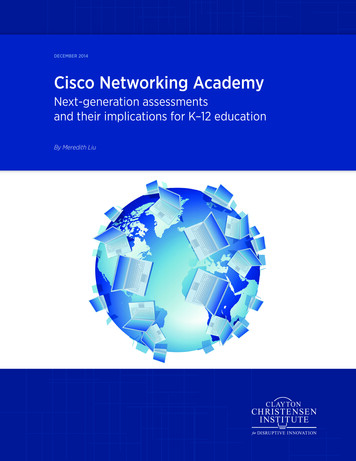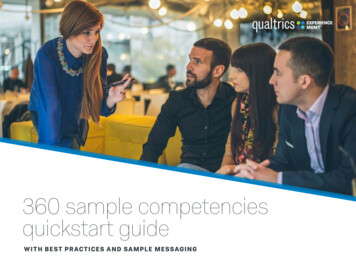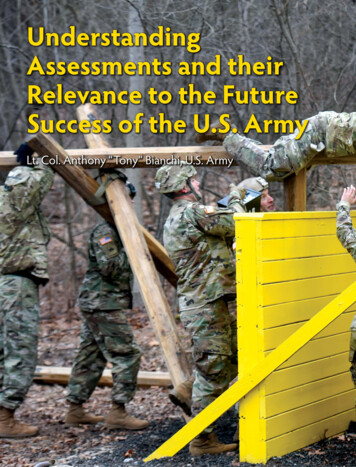
Transcription
UnderstandingAssessments and theirRelevance to the FutureSuccess of the U.S. ArmyLt. Col. Anthony “Tony” Bianchi, U.S. Army
Battalion Commander Assessment Program participants work togetherto negotiate an obstacle 23 January 2020 at the Alex Field LeaderReaction Course, Fort Knox, Kentucky. (Photo by Eric Pilgrim)
Today the U.S. Army is in a war for talent. Thecontinued existence of an all-volunteer forcerests on the Army’s ability to win this war byappropriately managing its number one resource—people. The director of the Army’s Talent ManagementTask Force (ATMTF), Maj. Gen. Joseph P. McGee,highlights how industry leaders talk about the war fortalent regarding the management of their people. “That‘war on talent’ is going to be a decisive factor on howwe fight future wars. One of [the Army’s] strengthsAssessments pertain to a successful implementation ofa new talent-based personnel system for the Army.According to Army Regulation 623-3, ArmyEvaluation Reporting System, evaluation reports are“independent assessments of how well the rated Soldiermet duty requirements and adhered to the professional standards of the Army’s Officer Corps or NCO[Noncommissioned Officer] Corps within the periodcovered by the report.”2 It is easy to conflate the termsof evaluation and assessment when defining an evalua-Evaluations provide snapshots of performances that aremostly subjective, whereas assessments provide objective data on an officer’s knowledge, skills, and behaviors.is the people that we bring in and the leaders that wedevelop.”1 To address this, the Army is moving awayfrom an industrial-age personnel management systemand toward a twenty-first-century talent managementsystem, beginning with the officer corps. The legacysystem, built on the tenets of strength management, isdata-poor, driven by rigid timelines, and focused on theinstitution. The new information-age talent management system is data-rich, flexible and transparent,aligns personnel based on talent, and places the preferences of the individual at a premium.Assessments are critical components of a twenty-first-century talent management system that supportsthe Army enterprise for a few reasons. First, assessmentsfacilitate the collection of granular data needed to drivemore informed decisions on personnel by the institution.Next, the use of assessments throughout an individual’s career will collectively drive behavior throughoutthe ranks in a positive way. Third, data collected fromassessments gives the Army a better way to identify gapsin its human capital necessary to dominate a peer threatin large-scale combat operations within a multi-domain,highly contested environment.Before going in depth on each of these key points,one must understand the difference between evaluations and assessments, the various types of assessments, and the unavoidable shift in mindset across theArmy as a result of this new culture of assessments.134tion in regulations. This conflation of terms within theArmy’s doctrine amplifies the lack of understandingabout assessments throughout the Army and perpetuates angst about this new culture of assessments.There are key differences between assessmentsand evaluations that need to be understood in orderto buy into this new culture. Evaluations providesnapshots of performances that are mostly subjective, whereas assessments provide objective data onan officer’s knowledge, skills, and behaviors (KSBs).Assessments provide a standardized lens throughwhich to compare individuals of the same rank acrossthe Army; evaluations compare individuals within aconstrained population dictated by the echelon andcriteria of the senior rater. Assessments go through arigorous scientific validation process and are reliableto provide accurate and detailed talent data on anindividual. Evaluations have no extensive validationprocess and rely heavily on the experience of thesenior rater’s opinion to gauge the talent and potentialof the rated individual. However, a senior rater’s experience-based opinion combined with the observedperformance of the rated individual during the ratingperiod is still very important and should have the majority of the input on that individual but not the soleinput. Evaluations should and will remain a huge partof the talent management process and, combined withassessments, provide a holistic view of an officer.May-June 2021MILITARY REVIEW
UNDERSTANDING ASSESSMENTSThe use of assessments throughout an officer’s oran NCO’s career creates a major paradigm shift. Thelegacy personnel system placed special emphasis onphysical fitness, hyper-compliance, and staying thecourse on a traditional combat arms career path. A newsystem would still value physical fitness and meetingcommander’s intent but will also value individual cognitive and noncognitive abilities, communication skills,and career path flexibility as important, if not arguablymore important, than physical fitness. The Army isvery comfortable with the use of assessments in thephysical fitness realm but very uncomfortable withusing assessments in the intellectual realm.In 2019, the Army instituted the Graduate RecordExam (GRE) at all the Captains Career Courses(CCC), mandating that all officers attending the CCCstake the GRE. The purpose of the GRE is to measurean individual’s ability to succeed in his or her first yearof graduate school. Specifically, the GRE measuresverbal reasoning, quantitative reasoning, critical thinking, and analytical writing skills.3 The GRE mandategarnered mixed reviews across the Army includingthose from senior leaders. One high-ranking generalofficer made the comment, “Jomini never took theGRE.”4 One could argue that Jomini never took theArmy Physical Fitness Test (APFT) either, but thecurrent culture in the Army has no problem conducting and using the APFT as a physical assessment.This simply illustrates the mindset change that mustoccur across the Army at every rank to acknowledgethat what someone has above the shoulders is just asimportant, if not more important, than what someonehas below the shoulders. The bottom line is the Armyneeds to become comfortable valuing intellect as muchas physical fitness, especially as rank increases.Furthermore, assessments are not somethingnew or a surprise in Army culture. In addition to theAPFT, multiple assessments already exist in the Army.Examples include the Armed Services VocationalAptitude Battery implemented in 1976 and theTailored Adaptive Personality System implemented in2009.5 The Army uses both assessments during the recruiting process to determine the best career choice forthe soldier when enlisting in the service. For decades,the Army Rangers, U.S. Army Special Forces, and otherelite special mission units utilized assessments as partof their overall selection and assignment processes. TheMILITARY REVIEWMay-June 2021idea of using assessments to gain more insight on anindividual before making a personnel decision is not anentirely new concept for the Army.Assessments only work if utilized for their intendedpurpose. Assessments fall into one of the three categories based on their validated purpose. The three typesof assessments are developmental, diagnostic, and predictive. Developmental assessments focus on the individual and provide individuals with information aboutthemselves in the form of strengths and weaknesses forpersonal development. Diagnostic assessments informthe institution on how to guide and develop an organization toward meeting organizational job requirements. The institution uses predictive assessments tomake assignment and selection decisions and can alsohave a developmental and diagnostic purpose as well.6However, there must be a balance between the amountof developmental and diagnostic feedback given to theindividual and institutionLt. Col. Anthony “Tony”respectively while proBianchi, U.S. Army, istecting the security anda field artillery officerintegrity of the predictiveattending the Nationalassessment.War College at FortExamples will betterMcNair, Washington, D.C.explain the usage of theHe holds a BS from thethree types of assessments.U.S. Military AcademyFor developmental, aand an MS from Georgewriting assessment takenMason University. Recentat the CCC or at theassignments include chiefCommand and Generalof assessments on theStaff Officer CollegeArmy Talent Management(CGSOC) IntermediateTask Force and comLevel Education informsmander of 3rd Battalion,select officers that their314th Field Artillery inwritten communicationFirst Army Division East.is weak. Those officersBianchi also served withcan elect to participate in17th and 214th Fieldself-development activiArtillery Brigades, theties to better their written82nd Airborne Division,communication ability. Forand the 3rd Infantrydiagnostic assessment, aDivision. He also taughtwriting assessment takenin the Department ofat the CCC informs theSystems Engineering atCombined Arms Centerthe U.S. Military Academythat a majority of captainsand achieved assistantacross the Army are weakprofessor status.in written communication.135
The result is a change in the curriculum across all CCCsto improve upon this aggregate gap. For predictiveassessment, a writing assessment taken at the BattalionCommander Assessment Program (BCAP) informsthe selection process that an officer is strong at written communication and adds objective support to thisofficer’s selection on the O5 Centralized Selection List(CSL). After understanding the difference between anevaluation and an assessment, the three types of assessments, and comprehending the culture shift that mustoccur throughout the Army, one can now begin to graspwhy assessments are so critical to a modern-day talentmanagement system for the Army.The first reason why assessments are essential to theimplementation of a new talent management systemfor the Army is that assessments facilitate the collectionof granular data needed to drive more informed decisions by the institution on its personnel. In 2019, twomajor Army talent management initiatives made theirdebut. The first was the Assignment Interactive Module2.0 (AIM 2), otherwise known as the assignment136Officers who were selected by the board to participate in the Battalion Commander Assessment Program pilot conduct standardizedtesting July 2019 at Fort Benning, Georgia. (Photo courtesy of theArmy Talent Management Task Force)marketplace. AIM 2 is a web-based information systemdesigned to enhance the effectiveness and efficiencyof the officer management process and facilitate communication between soldiers (e.g., officers and warrantofficers with talents), units (e.g., commanders withrequirements), and the Officer Personnel ManagementDirectorate.7 AIM 2 ensures that assignment decisionsare made using as much accurate data as possible andemploy a regulated market mechanism to better matchofficer talents to unit requirements.8 The other initiativeis the BCAP. BCAP is the U.S. Army’s new selectionprocess that assesses an officer’s fitness for battalioncommand. During the BCAP, officers take a series ofcognitive, noncognitive, physical, verbal, and writtenassessments. They also participate in psychologicalMay-June 2021MILITARY REVIEW
UNDERSTANDING ASSESSMENTSinterviews and conduct interviews with a “blind” panelof senior Army officers. Officer BCAP scores, combinedwith an officer’s standing on the CSL order of merit list,will inform a new order of merit list.9 In both cases, datafrom assessments was or will become a major factor todrive the successful execution of each initiative.As AIM 2 matures into the Integrated Personneland Pay System–Army, individuals will be able to useat the number of above-center-of-mass or most-qualified-block checks an officer received in his or her lastfive evaluations, how well an officer did in key anddevelopmental positions as a major, and the enumeration and stated potential by the senior rater in thefirst and last sentence of the soldier’s narrative portionon each evaluation. The BCAP provides more vectorsof information to assist in this selection of battalionAssessments given to officers at their precommissioning source, professional military education venues, andkey milestones such as battalion- and brigade-levelcommand selection will undoubtedly influence thebehavior of officers in their self-development.data from assessments to validate self-professed KSBs.Units can also use assessment data in the marketplaceto objectively measure potential hires. Additionally,assessment data obtained by the individual for developmental purposes can, at the discretion of theindividual, foster engaged discussion with units andinfluence an individual’s preference in the marketplacebased on known strengths. In the past, assignmentswere products of career managers at Human ResourcesCommand. Career managers used data inputs fromofficer evaluation reports and officer record briefs toalign “top” officers with career paths of their predecessors who were also successful officers under the legacysystem. This process had very little transparency andgave little emphasis to officer preference and aligningtalent. Assessment data will influence preferences forboth the individual and unit inside the Army TalentAlignment Process, the cornerstone of the AIM 2 marketplace. The result is a data-rich assignment marketplace that places the preferences of the individual at apremium while placing the right person in the right jobat the right time all the time.Much like the usage of assessments throughout anofficer’s career will change the culture of the Army, theBCAP changed the way the Army selects its lieutenantcolonel CSL positions. Historically, battalion commander selection was an outcome from a board thatspent less than two minutes reviewing an officer’s file.During this cursory review, the board primarily lookedMILITARY REVIEWMay-June 2021commanders or what Gen James C. McConville, thefortieth chief of staff of the Army, calls “the seed cornfor the Army’s future strategic leaders.”10 The resultwas a data-rich, holistic analysis and a more informeddecision by the institution to select officers to fill,arguably, the most consequential leadership positionsin the Army: battalion commanders. As BCAP continues to refine and imbed itself as the routine processof selecting battalion commanders going forward, thebehavior of officers coming through the ranks shouldchange as well. In September 2020, the Army executedthe inaugural Colonel Command Assessment Program,the brigade-level version of BCAP. Similar to BCAP, theColonel Command Assessment Program will changethe way the Army selects its colonel CSL positions andultimately drive the behavior of the officer corps as well.A career-long assessment structure will collectively drive behavior throughout the ranks in a positiveway. Assessments given to officers at their precommissioning source, professional military educationvenues, and key milestones such as battalion- andbrigade-level command selection will undoubtedlyinfluence the behavior of officers in their self-development. Similar to how the APFT, and more recentlythe Army Combat Fitness Test, became part of Armyculture and drove the soldier population to work onvarious techniques to improve select physical skills,career assessments will do the same for improvingintellectual and communication skills.137
Collaborative efforts are already underway betweenthe ATMTF, the Combined Arms Center, the Officeof Economic and Manpower Analysis at West Point,and the U.S. Army War College to ensure a synchronized career assessment program for Army officers.This career-long officer assessment structure beginswith giving assessments to all cadets at their precommissioning sources and continues with touch points atall the professional military education venues as well askey milestones like battalion- and brigade-commandselection. The purpose of these assessments variesbetween developmental and predictive. Assessmentstend to be more developmental early in an officer’scareer and more predictive later in his or her career.However, all the assessments have the ability to provide diagnostic data to the Army in a de-identifiedaggregate manner as needed.From 2013 to 2016, West Point piloted anothertalent management initiative: talent-based branching(TBB). The case for TBB was to optimize workforceproductivity by aligning cadets with the branch thathad the best fit for their talent.11 TBB uses a marketconcept with cadets preparing and submitting resumes on the supply side and branches articulatingjob requirements on the demand side in an effortto determine the best fit for both sides.12 A key element in making TBB work is the Talent AssessmentBattery (TAB). The TAB measures “the cognitive andnoncognitive skills, knowledge and behaviors of eachrelative to their peers and across the branches’ talentdemands.”13 The assessment data collected on cadetsfrom the TAB combined with the legacy order ofmerit list information derived from academic, military, and physical performance paints a more holisticpicture of the individual. The data from the TAB aspart of the TBB process enables the Army to betteralign cadets with their initial branch choice commensurate with the cadets’ and branches’ informed preference. Today, TBB is in full implementation at the U.S.Military Academy, Reserve Officers’ Training Corps,and Officer Candidate School.Assessment efforts at the Basic Officer LeaderCourse, CCC, and CGSOC are predominantly developmental and used to facilitate guided self-development.Data from these assessments will facilitate mandatorydiscussions between officers and their small-groupinstructors performing coaching duties using the “leader138as coach” methodology as part of guided self-development. There will also be at least one predictive assessment at CCC and CGSOC. The predictive assessmentat CCC will equip officers to make informed assignment decisions along a preferred and predictive careerpathway. The predictive assessment at CGSOC will influence the key developmental assignment process upongraduating CGSOC. Data from all assessments willalso facilitate voluntary interaction with a professional,International Coach Federation-certified coach as partof the Army Coaching Program to make an officer moreself-aware. In this scenario, officers have the discretionto share data from developmental assessments withthese professional career coaches to create individualdevelopment plans and review career options as theypertain to their KSBs and preferences.The ATMTF and the Center for StrategicLeadership at the U.S. Army War College are working together to provide a predictive assessment at thesenior service college level. Since 2018, the Center forStrategic Leadership piloted an assessment instrumentthat assesses strategic potential of officers in terms oftheir promotion potential to general officer and slatingat the enterprise level. The goal in the next year or twois to have a validated assessment that can assist theArmy in building cognitive dominant teams at the enterprise level that can win against a peer threat duringlarge-scale combat operations in a highly contested andever-changing multi-domain environment.Data collected from assessments gives the Army abetter way to identify gaps in its human capital necessary to dominate peer threats in the future. A May2020 article from the Army News Service highlights thecommander of the Army Futures Command, Gen. JohnM. Murray, as he emphasizes that having select talentwithin the Army ranks is the key to filling and executingsuccessfully in multi-domain operations. Specifically, thearticle stated, “The Multi-Domain Task Force is a modelof how the Army envisions joint-warfighting on futurebattlefields against near-peer competitors, like Russiaand China. Before the Army activates additional formations, though, Murray said it will first need the righttalent to fill the ranks.”14 Multiple expert opinions on thesubject of warfighting in the next fifteen to twenty yearsrevolve around heightened technology and the ability ofone side to better leverage technological advances acrossa multi-domain battlefield.May-June 2021MILITARY REVIEW
UNDERSTANDING ASSESSMENTSCyber expertise, nanotechnology, artificial intelligence, data science, and robotics are just some of thetechnical domains the Army will need to hone andbuild a bench in order to win future wars. Degrees andcertifications in certain disciplines may provide theArmy with a decent snapshot of technical competencies, or the lack thereof, within its personnel inventory.However, assessment data collected on individuals overtime will be able to give Army leaders a better idea ofthe personnel that possess the leadership attributesnecessary to acquire, integrate, and analyze technologyon the battlefield in an efficient manner. The Armywill need technologically savvy leaders who are able todecipher large amounts of information rapidly to makedecisions and flourish in a decentralized environment.Right now, the Army’s ability to conduct a humancapital inventory is only an inch deep and relies mainlyon officer record brief information such as rank, education level, discipline studied in college, military schooling, skill identifiers, language proficiency, and previousassignments. Assessment data can provide much moredetail to help the Army cover a blind spot and aid inthe talent management process.MILITARY REVIEWMay-June 2021Col. Joanne C. Moore gives a presentation on talent-based branching16 March 2017 during the 7th Annual Army G-8 Women’s Symposiumat the Pentagon, Arlington, Virginia. The process uses a battery of assessments to help cadets determine their branch preferences and bestfit. (Photo courtesy of the U.S. Army)Having an accurate inventory of personnel andassociated talents can assist in the resource alignmentand guidance for recruiters, the Reserve Officers’Training Command, and the U.S. Military Academy.As requirements for the Army grow to meet the needsof multi-domain operations, the need for more assessment data on individuals is paramount to shaping theforce for the future. Transforming civilians to work inbasic branches like infantry, armor, field artillery, andlogistics is not the problem. Finding the right personnelwho wear an Army uniform at echelon and buildingdepth in certain technological fields is the conundrum.Assessment data is essential to solving this problem.This article explained the basics of why assessmentsare essential to the Army’s new twenty-first-centurytalent management system; assessments facilitate the139
collection of granular data needed to assist the Army inmaking better decisions on its people. Assessments giventhroughout soldiers’ careers will positively drive the collective behavior of personnel. Data collected from assessments provides the Army with an understanding of itspeople’s KSBs so the Army can better manage the force.This article also explained the difference between evaluations and assessments, the various types of assessments,and the unavoidable shift in mindset across the Army as aresult of this new culture of assessments. Understandingthese fundamentals about assessments will hopefully alleviate some of the tension or concern that exists about theimplementation of assessments throughout the Army.The Army will continue to refine its career-long-assessments approach to the officer corps and look toimplement the same with its warrant officers and NCOcorps. Assessments are and will continue to be one ofthe main bridges between the industrial age, data-poorlegacy system built on performance management andquantity distribution to the information age and thedata-rich talent management system centered on talentalignment and individual preference. In reference tothe new talent management system, McGee statedduring an Association of the U.S. Army Institute ofLand Warfare breakfast in 2019, “The institutional requirements are to bring people in and to take a uniqueunderstanding of their knowledge, skills and behaviorsand preferences, what we call talents, and use that[understanding] over a career to manage them, so theycan most contribute to the mission of the United StatesArmy. It’s a simple recognition to this question, ‘Who’sthe best officer in the room?’ The answer is, ‘What jobare you considering them for?’”15 Assessments are theonly way the Army can accurately answer that questionthrough a detailed understanding of its number oneresource—people.Notes1. “319th ILW Breakfast-MG Joseph P. McGee-Nov. 14 2019,”YouTube video, 38:16, posted by “Association of the U.S. Army,”14 November 2019, accessed 4 January 2021, https://www.youtube.com/watch?v OFu0RAhtrH8.2. Army Regulation 623-3, Evaluation Reporting System(Washington, DC: U.S. Government Publishing Office, 2019), para.1-9, accessed 4 January 2021, pdf.3. “About the GRE General Test,” ETS, accessed 4 January 2021,https://www.ets.org/gre/revised general/about.4. A senior leader made a comment about Jomini never havingto take the Graduate Record Exam during an Army senior leaderupdate on talent management initiatives in February 2020.5. “History of Military Testing,” Armed Services VocationalAptitude Battery (ASVAB), accessed 4 January 2021, https://www.officialasvab.com/history res.htm. According to the official siteof the ASVAB, the ASVAB was first introduced for usage in themilitary in 1968 and later adopted by the Army in 1976; DavidVergun, “Personality Test Helps Ensure Civilians are Compatiblewith Army Life,” Army.mil, 19 May 2015, accessed 4 January ty test helps ensure civilians are compatible for army life.6. The definitions of developmental, diagnostic, and predictive assessments were developed and agreed upon by the Officeof Economic and Manpower Analysis, Army Research Institute,Center for the Profession and Leadership, and the Army TalentManagement Task Force in preparation for a brief to the chief ofstaff of the Army in March 2019.1407. “Assignment Interactive Module 2.0 (AIM 2)” (online presentation, U.S. Army Human Resources Command, Officer PersonnelManagement Directorate, April 2017), accessed 8 January ate/OPMD/What%20is%20AIM%202.pdf.8. Ibid.9. Deputy Chief of Staff G-1/Army Talent Management TaskForce, “Battalion Commander Assessment Program,” STAND-TO!,6 December 2019, accessed 4 January 2021, https://www.army.mil/standto/archive 2019-12-06/.10. James C. McConville and J. P. McGee, “Battalion CommandersAre the Seed Corn of the Army,” War on the Rocks, 23 December2019, accessed 4 January 2021, ders-are-the-seed-corn-of-the-army/.11. Michael J. Colarusso et al., Starting Strong: Talent-BasedBranching of Newly Commissioned U.S. Army Officers, Officer CorpsStrategy Monograph Series, vol. 9 (Carlisle, PA: Strategic StudiesInstitute and U.S. Army War College Press, 2016), 13, accessed 15January 2021, pdf.12. Ibid.13. Ibid., 25.14. Thomas Brading, “Talent Management Key to FillingFuture Specialized MDO Units,” Army.mil, 21 May 2020, accessed 4 January 2021, https://www.army.mil/article/235813/talent management key to filling future specialized mdo units.15. “319th ILW Breakfast-MG Joseph P. McGee-Nov. 14 2019,”YouTube video, 38:16.May-June 2021MILITARY REVIEW
physical fitness realm but very uncomfortable with using assessments in the intellectual realm. In 2019, the Army instituted the Graduate Record Exam (GRE) at all the Captains Career Courses (CC
